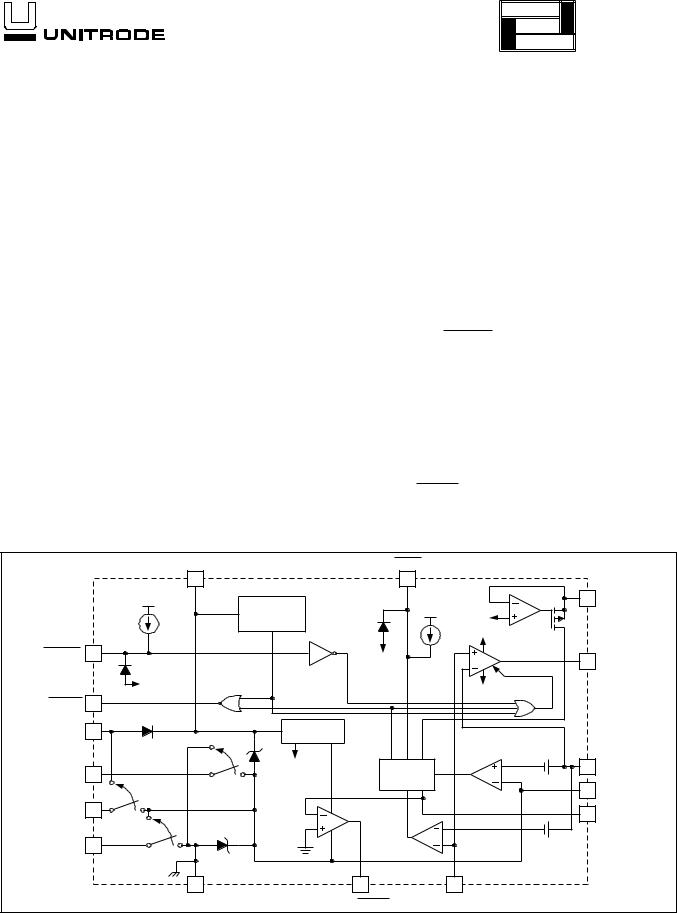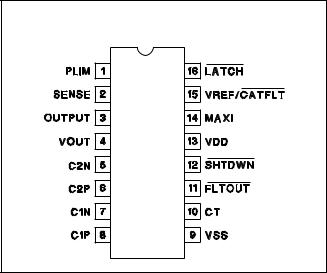Texas Instruments UCC3917N, UCC3917DTR, UCC3917D, UCC2917N, UCC2917DTR Datasheet
...
application
INFO
available
UCC1917
UCC2917
UCC3917
Positive Floating Hot Swap Power Manager
FEATURES
•Manages Hot Swap of 15V and Above
•Precision Fault Threshold
•Programmable Average Power Limiting
•Programmable Linear Current Control
•Programmable Overcurrent Limit
•Programmable Fault Time
•Internal Charge Pump to Control External NMOS Device
•Fault Output and Catastrophic Fault Indication
•Fault Mode Programmable to Latch or Retry
•Shutdown Control
•Undervoltage Lockout
DESCRIPTION
The UCC3917 family of positive floating hot swap managers provides complete power management, hot swap, and fault handling capability. The voltage limitation of the application is only restricted by the external component voltage limitations. The IC provides its own supply voltage via a charge pump off of VOUT. The onboard 10V shunt regulator protects the IC from excess voltage. The IC also has catastrophic fault indication to alert the user that the ability to shut off the output NMOS has been bypassed. All control and housekeeping functions are integrated and externally programmable. These include the fault current level, maximum output sourcing current, maximum fault time, soft start time, and average NMOS power limiting.
The fault level across the current sense amplifier is fixed at 50mV to minimize total drop out. Once 50mV is exceeded across the current sense resistor, the fault timer will start. The maximum allowable sourcing current is programmed with a voltage divider from the VREF/CATFLT pin to generate a fixed voltage on the MAXI pin. The current level at which the output appears as a current source is equal to VMAXI divided by the current sense resistor. If desired, a controlled current startup can be programmed with a capacitor on MAXI.
When the output current is below the fault level, the output device is switched on with full gate drive. When the output current exceeds the fault level, but is less than maximum allowable sourcing level programmed by MAXI, the output remains switched on, and the fault timer starts charging CT. Once CT charges to 2.5V, the output device is turned off and attempts either a retry sometime later or waits for the state on the LATCH pin to change if in latch mode. When the output current reaches the maximum sourcing current level, the output device appears as a current source.
BLOCK DIAGRAM
|
VDD |
|
LATCH |
|
|
|
|
|
|
|
|
13 |
|
16 |
|
|
|
|
|
|
|
|
V |
UVLO |
|
|
|
|
|
|
1 |
PLIM |
|
DD |
|
VDD |
|
|
|
|
|
|
|
|
40 A |
>10V=ENABLE |
|
|
5V |
|
|
|
|
|
|
< 6V=DISABLE |
|
|
|
|
|
|
|
||
|
|
|
|
VDD |
|
|
|
|
||
|
|
|
|
|
|
|
|
|
||
|
|
|
|
|
40 A |
|
|
|
|
|
|
|
|
|
|
|
|
|
|
|
|
SHTDWN |
12 |
|
|
|
|
DISABLE |
|
|
|
|
|
VOUT |
|
|
|
|
|
3 |
OUTPUT |
||
|
|
|
|
|
|
|
|
|||
|
VOUT |
|
|
|
|
VOUT |
OUTPUT |
|
|
|
|
|
|
|
|
|
LOW |
|
|
||
FLTOUT |
11 |
|
|
|
|
|
|
|
||
|
|
|
|
|
|
|
|
|
||
C1P |
8 |
5V |
|
|
|
OVER |
|
|
|
|
REFERENCE |
|
|
|
|
|
|
||||
|
|
|
|
CURRENT |
|
|
|
|
||
|
|
|
|
|
|
|
50mV |
|
|
|
|
|
|
|
|
COMPARATOR |
|
|
|||
|
|
LOGIC |
ON-TIME |
|
|
|
+ |
2 |
SENSE |
|
C1N |
7 |
|
|
|
|
|||||
SUPPLY |
|
|
|
|
|
|
||||
DELAY |
|
|
|
|
|
|
|
|||
|
|
|
|
|
|
|
|
|
|
|
|
|
|
|
|
|
|
|
|
4 |
VOUT |
C2P |
6 |
|
|
|
|
|
|
|
10 |
CT |
|
|
|
|
|
|
|
|
|
||
|
|
|
|
|
|
|
|
+ |
|
|
C2N |
5 |
4V |
|
|
|
|
|
200mV |
|
|
|
|
|
|
|
|
|
|
|||
|
9 |
|
15 |
|
14 |
|
|
|
|
|
|
VSS |
|
VREF/CATFLT |
|
MAXI |
|
|
|
|
UDG-99055 |
|
|
|
|
|
|
|
|
|||
SLUS203A - AUGUST 1999 |
|
|
|
|
|
|
|
|
|
|

ABSOLUTE MAXIMUM RATINGS
IDD . . . . . . . . . . . . . . . . . . . . . . . . . . . . . . . . . . . . . . . . . . 20mA SHTDWN Current . . . . . . . . . . . . . . . . . . . . . . . . . . . . . –500 A LATCH Current . . . . . . . . . . . . . . . . . . . . . . . . . . . . . . . –500 A VREF Current . . . . . . . . . . . . . . . . . . . . . . . . . . . . . . . . –500 A PLIM Current . . . . . . . . . . . . . . . . . . . . . . . . . . . . . . . . . . 10mA MAXI Input Voltage . . . . . . . . . . . . . . . . . . . . . . . . . VDD + 0.3V Storage Temperature . . . . . . . . . . . . . . . . . . . –65°C to +150°C Junction Temperature. . . . . . . . . . . . . . . . . . . –55°C to +150°C Lead Temperature (Soldering, 10 sec.) . . . . . . . . . . . . . +300°C
Currents are positive into, negative out of the specified terminal. Consult Packaging Section of Databook for thermal limitations and considerations of package.
UCC1917
UCC2917
UCC3917
CONNECTION DIAGRAM
DIL-16, SOIC-16 (Top View)
J or N Package, D Package
ELECTRICAL CHARACTERISTICS: Unless otherwise specified, TA = 0°C to 70°C for the UCC3917, –40°C to 85° for the UCC2917 and –55°C to 125°C for the UCC1917, CT = 4.7nF. TA = TJ. All voltages are with respect to VOUT. Current is positive into and negative out of the specified terminal.
PARAMETER |
|
|
TEST CONDITIONS |
MIN |
TYP |
MAX |
UNITS |
VDD Section |
|
|
|
|
|
|
|
IDD |
|
From VOUT (Note 1) |
3.0 |
5 |
11 |
mA |
|
UVLO Turn On Threshold |
|
|
|
7.9 |
8.8 |
9.7 |
V |
UVLO Off Voltage |
|
|
|
5.5 |
6.5 |
7.5 |
V |
VSS Regulator Voltage |
|
|
|
–6 |
–5 |
–4 |
V |
Fault Timing Section |
|
|
|
|
|
|
|
Overcurrent Threshold |
|
TA = 25°C |
47.5 |
50 |
53 |
mV |
|
|
Over Operating Temperature |
46 |
50 |
54 |
mV |
||
Overcurrent Input Bias |
|
|
|
|
50 |
500 |
nA |
CT Charge Current |
|
VCT = 1V |
–78 |
–50 |
–28 |
A |
|
CT Catastrophic Fault Threshold |
|
|
|
3.4 |
|
4.5 |
V |
CT Fault Threshold |
|
|
|
2.25 |
2.5 |
2.75 |
V |
CT Reset Threshold |
|
|
|
0.32 |
0.5 |
0.62 |
V |
Output Duty Cycle |
|
Fault Condition |
1.7 |
2.7 |
3.7 |
% |
|
Output Section |
|
|
|
|
|
|
|
Output High Voltage |
|
IOUT = 0 |
6 |
8 |
10 |
V |
|
|
|
IOUT = –500 A |
5 |
7 |
9 |
V |
|
Output Low Voltage |
|
IOUT = 0 |
|
0 |
0.05 |
V |
|
|
|
IOUT = 500 A |
|
0.1 |
0.5 |
V |
|
|
|
IOUT = 1mA |
|
0.5 |
0.9 |
V |
|
Linear Current Section |
|
|
|
|
|
|
|
Sense Control Votlage |
|
MAXI = 100mV |
85 |
100 |
115 |
mV |
|
|
|
MAXI = 400mV |
370 |
400 |
430 |
mV |
|
Input Bias |
|
MAXI = 200mV |
|
50 |
500 |
nA |
|
SHUTDOWN Section |
|
|
|
|
|
|
|
Shutdown Threshold |
|
|
|
2.0 |
2.4 |
2.8 |
V |
|
|
|
|
|
|
|
A |
Input Current |
|
SHTDWN = 0V |
24 |
40 |
60 |
||
Shutdown Delay |
|
|
|
|
100 |
500 |
ns |
2

UCC1917
UCC2917
UCC3917
ELECTRICAL CHARACTERISTICS: Unless otherwise specified, TA = 0°C to 70°C for the UCC3917, –40°C to 85° for the UCC2917 and –55°C to 125°C for the UCC1917, CT = 4.7nF. TA = TJ. All voltages are with respect to VOUT. Current is positive into and negative out of the specified terminal.
PARAMETER |
|
|
TEST CONDITIONS |
MIN |
TYP |
MAX |
UNITS |
||
LATCH Section |
|
|
|
|
|
|
|
|
|
Latch Threshold |
|
|
|
|
|
1.7 |
2 |
2.3 |
V |
Input Current |
LATCH = 0V |
24 |
40 |
60 |
A |
||||
Fault Out Section |
|
|
|
|
|
|
|
|
|
Fault Output High |
|
|
|
|
|
6 |
8 |
10 |
V |
Fault Output Low |
|
|
|
|
|
|
0.01 |
0.05 |
V |
Power Limiting Section |
|
|
|
|
|
|
|
|
|
VSENSE Regulator Voltage |
IPLIMIT = 64 A |
4.5 |
5 |
5.5 |
V |
||||
Duty Cycle Control |
IPLIMIT = 64 A |
0.6 |
1.2 |
1.7 |
% |
||||
|
IPLIMIT = 1mA |
0.045 |
0.1 |
0.2 |
% |
||||
VREF/CATFLT Section |
|
|
|
|
|
|
|
|
|
VREF Regulator Voltage |
|
|
|
|
|
4.5 |
5 |
5.5 |
V |
Fault Output Low |
|
|
= 5mA |
|
0.22 |
0.50 |
V |
||
IVREF/CATFLT |
|
||||||||
Output Sink Current |
|
|
|
|
|
|
|
|
|
VCT = 5V, VVREF/CATFLT |
= 5V |
15 |
40 |
70 |
mA |
||||
Overload Comparator Threshold |
Relative to MAXI |
110 |
200 |
290 |
mV |
||||
Note 1: Set by user with RSS.
PIN DESCRIPTIONS
C1N: Negative side of the upper charge pump capacitor.
C1P: Positive side of the upper charge pump capacitor.
C2N: Negative side of the lower charge pump capacitor.
C2P: Positive side of lower charge pump capacitor.
CT: A capacitor is connected to this pin to set the fault time. The fault time must be more than the time to charge the external load capacitance (see Application Information).
FLTOUT: This pin provides fault output indication. Interface to this pin is usually performed through level shift transistors. Under a non-fault condition, FLTOUT will pull to a high state. When a fault is detected by the fault timer or the under voltage lockout, this pin will drive to a low state, indicating the output NMOS is in the off state.
LATCH: Pulling this pin low causes a fault to latch until this pin is brought high or a power on reset is attempted. However, pulling this pin high before the reset time is reached will not clear the fault until the reset time is reached. Keeping LATCH high will result in normal operation of the fault timer. Users should note there will be an RC delay dependent upon the external capacitor at this pin.
MAXI: This pin programs the maximum allowable sourcing current. Since VREF/CATFLT is a regulated voltage, a voltage divider can be derived to generate the program level for MAXI. The current level at which the output appears as a current source is equal to the volt-
age on MAXI divided by the current sense resistor. If desired, a controlled current start up can be programmed with a capacitor on MAXI (to VOUT), and a programmed start delay can be achieved by driving the shutdown with an open collector/drain device into an RC network.
OUTPUT: Gate drive to the NMOS pass element.
PLIM: This feature ensures that the average external NMOS power dissipation is controlled. A resistor is connected from this pin to the drain of the external NMOS pass element. When the voltage across the NMOS exceeds 5V, current will flow into PLIM which adds to the fault timer charge current, reducing the duty cycle from the 3% level.
SENSE: Input voltage from the current sense resistor. When there is greater than 50mV across this pin with respect to VOUT, a fault is sensed, and CT starts to charge.
SHTDWN: This pin provides shutdown control. Interface to this pin is usually performed through level shift transistors. When shutdown is driven low, the output disables the NMOS pass device.
VDD: Power to the I.C. Is supplied by an external current limiting resistor on initial power-up or if the load is shorted. As the load voltages rises (VOUT), a small amount of power is drawn from VOUT by an internal charge pump. The charge pump’s input voltage is regulated by an on-chip 5V zener. Power to VDD is supplied
3
